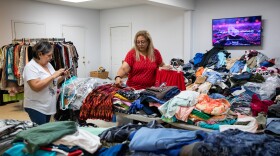"[T]hey’re having me wait on the other side, but I see you."
That was the message that appeared on my iPhone last Wednesday afternoon from KUT photographer Lorianne Willett.
Weird.
Not even half an hour earlier, I had perched on the edge of the bridge she was trying to cross, watching as search and rescue workers carefully combed through a nearby pile of tangled tree branches and debris.
We were out by Big Sandy Creek, and Lorianne was trying to meet up with me and other KUT reporters. The northwestern Travis County neighborhood had been hit by intense flash flooding that swept through the creek over the Fourth of July weekend.
It had been nearly two weeks since the floods that ultimately left at least 18 people dead in the Austin area. This day was the first time I noticed cadaver dogs in the same area where I was reporting.
I glanced at my phone, again, to make sure I hadn’t misread her message, and began walking toward the bridge.
The bridge itself had been severely damaged by floodwaters — leaving some people in the neighborhood trapped on one side of the creek for more than week. A new low water crossing constructed parallel to bridge has fixed that issue — at least temporarily. But many people, including me, continued to use the damaged bridge — preferring to walk instead of drive.
As I made my way to find Lorianne, I stopped at one of the pop-up canopy tents near the neighborhood's entrance. From there, I was close enough to see the yellow crime scene tape that had been put up to prevent people from crossing the bridge.
"What’s going on?" I asked one of the volunteers standing nearby.
"They found someone," the middle-aged man replied.
"Where? Underneath?" I asked, pointing to the bridge.
He nodded his head grimly.
I slowly walked over and peeked down, around one side of the bridge. The crew of search and rescue workers was now huddled around the dozer blade of a large red excavator.
I sent Lorianne a short message to let her know why she couldn't cross the bridge.
"They just found a body that’s why," I wrote.
But when I looked up, she was standing right in front of me. A Texas Department of Public Safety officer had escorted her past the yellow crime scene tape and across the bridge, she told me.
After checking-in with the other reporters, Lorianne and I decided to trudge down to one of the houses along the creek to take a portrait of the homeowner. A group of volunteers was still out in front of the house, hauling away debris in wheelbarrows. Along the way, movement underneath the bridge caught my eye.
Five search and rescue workers were still huddled around the large red excavator. They were pulling on blue gloves. A forensic photographer was also down there now, taking pictures. The crew was preparing, we realized, to remove the body, which was still not visible underneath the mass of tree branches and debris.
Suddenly, it became eerily silent. My stomach dropped and I held my breath. I looked back at the house we stood in front of and realized the volunteers were gone. They had all seemingly vanished — except for two men. One of the men furiously, but unsuccessfully, attempted to start his chainsaw, pulling at the cord with no luck.
"Are you OK?," I asked Lorianne. "We can go. We don't have to watch this."
"I'm OK," she said.
We stood there in silence, and watched as the search and rescue workers began tenderly removing branches in front of the excavator. After a few minutes, they stopped. One worker pulled out a yellow tarp. They carefully unfolded it, and laid it across the body that was still, at this point, hidden by branches.
The crew then paused, again. A few minutes went by before they pulled the tarp-covered body out from underneath the tree branches. They gingerly placed it a few feet away — behind a black curtain, blocking it from the public's view.
I let out a deep breath and looked at Lorianne.
"Are you OK?" I asked, again.
She nodded.
It was only then that I heard the revving sound. The man next us had finally managed to start his chainsaw.











